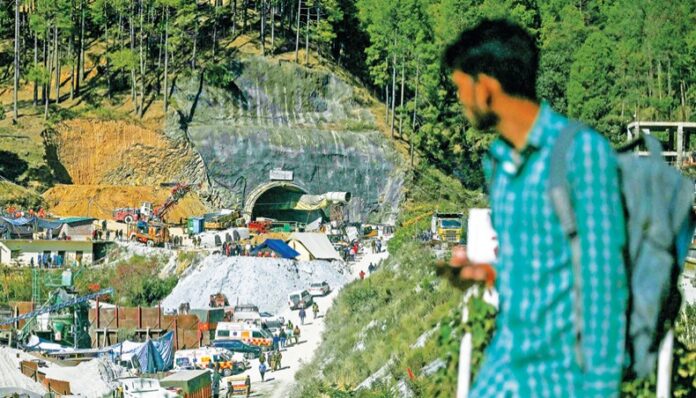Environmental campaigners urge, while development is needed, the breakneck pace is causing problems
A surge of unregulated building development replacing forests pose serious problem for hills

Ravindra Ojha
India’s aggressive infrastructure push into the ecologically fragile Himalayan mountains has been given a “warning and wake-up call” by the collapse of a road tunnel that trapped 41 men, environmental experts say. The partial cave-in of the under-construction Silkyara road tunnel in northern Uttarakhand state nearly two weeks ago — with the desperate men still awaiting rescue — was only the latest disaster in the geologically unstable region.
The tunnel collapse has sent shockwaves through the nation, serving as a poignant reminder of the delicate balance between development and environmental conservation. As the Modi government forges ahead with its ambitious infrastructure drive, environmental campaigners are sounding an alarm, cautioning against the breakneck pace of development that threatens the very foundations of the hills.
The Need for Development:
There is no denying the importance of infrastructural development in a rapidly growing nation like India. Modernizing transportation, connectivity, and energy infrastructure is crucial for fostering economic growth, creating job opportunities, and improving the overall quality of life for citizens. The Modi government’s commitment to these goals is commendable, but the recent incident in Uttarakhand underscores the urgency of striking a balance between progress and environmental sustainability.
Unregulated Building Development: A Serious Threat
One of the primary concerns raised by environmental campaigners is the surge of unregulated building development that is rapidly replacing pristine forests in the hills. The allure of progress has led to a hasty and often unchecked construction spree, resulting in the destruction of vital ecosystems. The consequences of such actions are not limited to the loss of biodiversity; they extend to the destabilization of hillsides and an increased risk of natural disasters.
Tunnel Collapse as a Wake-Up Call:
The collapse of a tunnel in Uttarakhand serves as a stark wake-up call for the Modi government. While investigations are still underway to determine the exact causes of the incident, environmentalists argue that the rampant and unplanned construction in the region could be a significant contributing factor. The hills, with their fragile geology, cannot bear the brunt of unchecked development without dire consequences.
The Urgent Need for Regulation:
As the government pushes ahead with its infrastructure projects, it is imperative to implement stringent regulations to ensure sustainable development. Environmental impact assessments, community consultations, and comprehensive studies on the geological stability of the areas targeted for construction must be mandatory components of any project. The focus should not solely be on completing projects swiftly but on ensuring their longevity and minimizing the negative impact on the environment.
Collaboration with Environmental Experts:
To strike the delicate balance between development and conservation, the government must actively engage with environmental experts, ecologists, and local communities. Their insights can provide invaluable guidance on designing infrastructure projects that meet the needs of the people while preserving the natural heritage of the hills. Collaboration will help in identifying ecologically sensitive zones and formulating strategies to protect them.
The tunnel collapse in Uttarakhand should serve as a turning point in the Modi government’s infrastructure drive. While development is essential for progress, it must be approached with a deep commitment to environmental stewardship. The hills are not just a canvas for construction; they are delicate ecosystems that demand careful consideration. By embracing sustainable practices and incorporating the wisdom of environmental experts, the government can pave the way for a future where development and conservation coexist harmoniously. The choice is clear: it’s time to build a sustainable tomorrow for the hills of Uttarakhand.
Added to that are the challenges caused by rising global temperatures unleashing a cascade of extreme weather that scientists warn will get worse. “The scale and extent of the infrastructure development needs a complete rethink,” Shripad Dharmadhikary, an environmental researcher and veteran activist, told The Emerging World.
India’s monsoon rains mean flooding is common, but major infrastructure projects in the mountains — including hydroelectric dams, railways and roads — are being built in areas hit ever harder by storm surges and landslides. “It is one thing to build roads for local connectivity,” Dharmadhikary said. “But roads for big hydropower projects are much wider, increasing vulnerability and risk… Scale makes a big difference.”
‘Risks ignored’:
Raghav Chandra, ex-chairman of the National Highways Authority of India (NHAI), warned that “building a tunnel through a mountain is perilous”, but dangers were multiplied when such large-scale projects are poorly carried out. “The accident is a wake-up call about the perils of undertaking massive construction projects in the fragile Himalayan range, which is under threat from intense human activity and the vagaries of the climate crisis,” Chandra told this correspondent.
The Himalayas — the world’s highest mountain range, with peaks driven upwards by colliding continental plates — is one of the globe’s most seismically active regions, with earthquakes common. Scientists say glaciers in the Himalayas are melting faster than ever due to climate change, exposing communities to unpredictable and costly disasters.
UN Secretary-General Antonio Guterres recently said Himalayan regions were struggling with rapidly melting glaciers, warning on a visit to neighbouring Nepal that the “rooftops of the world are caving in.” The Silkyara tunnel is part of Prime Minister Narendra Modi’s infrastructure project aimed at cutting travel times between some of the most popular Hindu temples in the country. The 4.5-kilometre (2.7-mile) passage is meant to connect Uttarkashi and Yamunotri, two of the holiest sites.
For Mod, the grand projects help burnish his appeal, with elections due next year. But India’s projects are also focused on improving access to strategic areas bordering rival China. New Delhi has been wary of Beijing’s growing military assertiveness and their 3,500-kilometre shared frontier has been a perennial source of tension. “Tunnelling helps to reduce travel time and plays a strategic role by enabling quicker passage of defence armaments and military troops,” Chandra added. “But, with the growing urgency to speed up construction, the manifold risks and challenges involved… are often ignored.”
‘Course correction’:
After the Silkyara collapse, the NHAI said it would assess all 29 under-construction tunnels to “ensure safety and adherence to the highest quality standards.” Arnold Dix, president of the International Tunnelling and Underground Space Association, pointed out the advantages of building tunnels. “The environmental footprint of a tunnel is likely to be less than the environmental footprint of a much larger and more complex road,” Dix told The Emerging World at the Silkyara tunnel site, where he is helping rescue efforts.
Campaigners say that while development is needed, the breakneck pace is causing problems, including a surge of unregulated building development replacing the forests that helped keep hillsides stable. “This decade… the Himalayas have been tunnelled, blasted, cut, gouged, turned to rubble and concretised as never before,” environmental campaigner Amit Pandey wrote in the The Emerging World this week.
“The development model in this young, fragile mountain range has been disastrous and needs course correction,” added Pandey, head of Himalayan Sansad, a community group working to protect the Himalayas and the watershed of the Ganges river. “Mega-projects are not what the Himalayas are about, culturally or geologically.”
(Writer is the Political Editor, The Emerging World)


